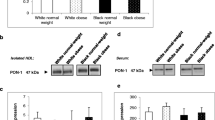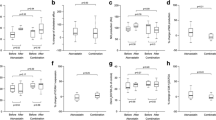Abstract
Plasma lipids have been extensively studied in sedentary and in subjects practicing exercise training, but not in extreme inactivity as occurs in bedridden patients. This is important for the care of bedridden patients and understanding the overall plasma lipid regulation. Here, we investigated plasma lipids, lipid transfers to HDL and inflammatory markers in bedridden patients. Fasting blood samples were collected from 23 clinically stable bedridden patients under long-term care (>90 days) and 26 normolipidemic sedentary subjects, paired for age and gender. In vitro transfer of four lipids to HDL was performed by incubating plasma with donor nanoparticles containing radioactive lipids. Total (193 ± 36 vs 160 ± 43, p = 0.005), LDL (124 ± 3 vs 96 ± 33 p = 0.003) and HDL-cholesterol (45 ± 10 vs 36 ± 13, p = 0.008), apolipoprotein A-I (134 ± 20 vs 111 ± 24, p = 0.001) and oxidized LDL (53 ± 13 vs 43 ± 12, p = 0.011) were lower in bedridden patients, whereas triglycerides, apolipoprotein B, CETP and LCAT were equal in both groups. Transfers of all lipids, namely unesterified cholesterol, cholesterol esters, triglycerides and phospholipids, to HDL were lower in bedridden patients, probably due to their lower HDL-cholesterol levels. Concentrations of IL-1β, IL-6, IL-8, HGF and NGF were higher in bedridden patients compared to sedentary subjects. In conclusion, inactivity had great impact on HDL, by lowering HDL-cholesterol, apolipoprotein A-I and thereby cholesterol transfers to the lipoprotein, which suggests that inactivity may deteriorate HDL protection beyond the ordinary sedentary condition.
Similar content being viewed by others
Abbreviations
- apo:
-
Apolipoprotein
- BMI:
-
Body mass index
- CETP:
-
Cholesterol ester transfer protein
- HDL:
-
High density lipoprotein
- HGF:
-
Hepatocyte growth factor
- IL:
-
Interleukin
- LDL:
-
Low density lipoprotein
- LCAT:
-
Lecithin-cholesterol acyltransferase
- MCP-1:
-
Monocyte chemotactic protein
- NGF:
-
Nerve growth factor
- RCT:
-
Reverse cholesterol transport
- TNF-α:
-
Tumor necrosis factor-α
References
Halverstadt A, Phares DA, Wilund KR, Goldberg AP, Hagberg JM (2007) Endurance exercise training raises high-density lipoprotein cholesterol and lowers small low-density lipoprotein and very low-density lipoprotein independent of body fat phenotypes in older men and women. Metabolism 56:444–450
Durstine JL, Grandjean PW, Cox CA, Thompson PD (2002) Lipids, lipoproteins, and exercise. J Cardiopulm Rehabil 22:385–398
Lira FS, Rosa JC, Lima-Silva AE, Souza HA, Caperuto EC, Seelaender MC, Damaso AR, Oyama LM, Santos RV (2010) Sedentary subjects have higher PAI-1 and lipoproteins levels than highly trained athletes. Diabetol Metab Syndr 22:2–7
Lee IM, Shiroma EJ, Lobelo F, Puska P, Blair SN, Katzmarzyk PT (2012) Effect of physical inactivity on major non-communicable diseases worldwide: an analysis of burden of disease and life expectancy. Lancet 380:219–229
Wang M, Briggs MR (2004) HDL: the metabolism, function and therapeutic importance. Chem Rev 104:119–137
Falk E (2006) Pathogenesis of atherosclerosis. J Am Coll Cardiol 47:C7–C12
Yu R, Yekta B, Vakili L, Gharavi N, Navab M, Marelli D, Ardehali A (2008) Proatherogenic high-density lipoprotein, vascular inflammation, and mimetic peptides. Curr Atheroscler Rep 10:171–176
Navab M, Anantharamaiah GM, Reddy ST, Van Lenten BJ, Ansell BJ, Fogelman AM (2006) Mechanisms of disease: proatherogenic HDL—an evolving field. Nat Clin Pract Endocrinol Metab 2:504–511
Tölle M, Huang T, Schuchardt M, Jankowski V, Prüfer N, Jankowski J, Tietge UJ, Zidek W, van der Giet M (2012) High-density lipoprotein loses its anti-inflammatory capacity by accumulation of pro-inflammatory-serum amyloid A. Cardiovasc Res 94:154–162
Dullaart RP, de Boer JF, Annema W, Tietge UJ (2013) The inverse relation of HDL anti-oxidative functionality with serum amyloid A is lost in metabolic syndrome subjects. Obesity (Silver Spring) 21:361–366
Lo Prete AC, Dina CH, Azevedo CH, Puk CG, Lopes NH, Hueb WA, Maranhão RC (2009) In vitro simultaneous transfer of lipids to HDL in coronary artery disease and in statin treatment. Lipids 44:917–924
Maranhão RC, Freitas FR (2014) HDL metabolism and atheroprotection: predictive value of lipid transfers. Adv Clin Chem 65:1–41
Barter JP (2000) CETP and atherosclerosis. Arterioscler Thromb Vasc Biol 20:2029–2031
Huuskonen J, Olkkonen VM, Jauhiainen M, Ehnholm C (2001) The impact of phospholipid transfer protein (PLTP) on HDL metabolism. Atherosclerosis 155:269–281
Albers JJ, Vuletic S, Cheung MC (2012) Role of plasma phospholipid transfer protein in lipid and lipoprotein metabolism. Biochim Biophys Acta 1821:345–357
Vaisberg M, Bachi AL, Latrilha C, Dioguardi GS, Bydlowski SP, Maranhão RC (2012) Lipid transfer to HDL is higher in marathon runners than in sedentary subjects, but is acutely inhibited during the run. Lipids 47:679–686
da Silva JL, Vinagre CG, Morikawa AT, Alves MJ, Mesquita CH, Maranhão RC (2011) Resistance training changes LDL metabolism in normolipidemic subjects: a study with a nanoparticle mimetic of LDL. Atherosclerosis 219:532–537
Casella-Filho A, Chagas AC, Maranhão RC, Trombetta IC, Cesena FH, Silva VM, Tanus-Santos JE, Negrão CE, da Luz PL (2011) Effect of exercise training on plasma levels and functional properties of high-density lipoprotein cholesterol in the metabolic syndrome. Am J Cardiol 107:1168–1172
Ginsburg GS, Ginsburg GS, Atikinson D (1982) Microemulsions of phospholipids and cholesterol esters. Protein-free models of low density lipoprotein. J Biol Chem 257:8216–8227
Maranhão RC, Cesar TB, Pedroso-Mariani SR, Hirata MH, Mesquita CH (1993) Metabolic behavior in rats of a non protein microemulsion resembling low-density lipoprotein. Lipids 28:691–696
Barter P, Kastelein J, Nunn A, Hobbs R (2003) High density lipoproteins (HDLs) and atherosclerosis; the unanswered questions. Atherosclerosis 168:195–211
Vinagre CG, Ficker ES, Finazzo C, Alves MJ, de Angelis K, Irigoyen MC, Negrão CE, Maranhão RC (2007) Enhanced removal from the plasma of LDL-like nanoparticle cholesteryl ester in trained men compared with sedentary healthy men. J Appl Physiol 103:1166–1171
Levitan I, Volkov S, Subbaiah PV (2010) Oxidized LDL: diversity, patterns of recognition, and pathophysiology. Antioxid Redox Signal 13:39–75
Parthasarathy S, Raghavamenon A, Garelnabi MO, Santanam N (2010) Oxidized low-density lipoprotein. Methods Mol Biol 610:403–417
Jung RT (1997) Obesity as a disease. Br Med Bull 53:307–321
Maranhão RC, Freitas FR, Strunz CM, Santos RD, Mansur AJ, Mansur AP (2012) Lipid transfers to HDL are predictors of precocious clinical coronary heart disease. Clin Chim Acta 413:502–505
Sprandel MC, Hueb WA, Segre A, Ramires JA, Kalil-Filho R, Maranhão RC (2015) Alterations in lipid transfers to HDL associated with the presence of coronary artery disease in patients with type 2 diabetes mellitus. Cardiovasc Diabetol 14:107–115
Rousset X, Shamburek R, Vaisman B, Amar M, Remaley AT (2011) Lecithin cholesterol acyltransferase: an anti- or pro-atherogenic factor? Curr Atheroscler Rep 13:249–256
Davies AL, Hayes KC, Dekaban GA (2007) Clinical correlates of elevated serum concentrations of cytokines and autoantibodies in patients with spinal cord injury. Arch Phys Med Rehabil 88:1384–1393
Yang L, Blumbergs PC, Jones NR, Manavis J, Sarvestani GT, Ghabriel MN (2004) Early expression and cellular localization of proinflammatory cytokines interleukin-1beta, interleukin-6, and tumor necrosis factor-alpha in human traumatic spinal cord injury. Spine 29:966–971
Bank M, Stein A, Sison C (2015) Elevated circulating levels of the pro-inflammatory cytokine macrophage migration inhibitory factor in individuals with acute spinal cord injury. Arch Phys Med Rehabil 96:633–644
Kwon BK, Stammers AM, Belanger LM, Bernardo A, Chan D, Bishop CM, Slobogean GP, Zhang H, Umedaly H, Giffin M, Street J, Boyd MC, Paquette SJ, Fisher CG, Dvorak MF (2010) Cerebrospinal fluid inflammatory cytokines and biomarkers of injury severity in acute human spinal cord injury. J Neurotrauma 27:669–682
Bachi ALL, Rocha GA, Sprandel MCO, Ramos LR, Gravina CF, Pithon-Curi TC, Vaisberg M, Maranhão RC (2015) Exercise training improves plasma lipid and inflammatory profiles and increases cholesterol transfer to high-density lipoprotein in elderly women. J Am Geriatr Soc 63:1247–1249
Porat O (1989) The effect of tumor necrosis factor alpha on the activity of lipoprotein lipase in adipose tissue. Lymphokine Res 8:459–469
Mackay AG, Oliver JD, Rogers MP (1990) Regulation of lipoprotein lipase activity and mRNA content in rat epididymal adipose tissue in vitro by recombinant tumour necrosis factor. Biochem J 269:123–126
Marsche G, Saemann MD, Heinemann A, Holzer M (2013) Inflammation alters HDL composition and function: implications for HDL-raising therapies. Pharmacol Ther 137:341–351
Burger D, Dayer JM (2002) High-density lipoprotein-associated apolipoprotein A-I: the missing link between infection and chronic inflammation? Autoimmun Rev 1:111–117
Acknowledgements
The authors are thankful to Mrs. Josefa M.H.S. Lima BSc, for her help with the experiments.
Author information
Authors and Affiliations
Contributions
Authors contribution
WPCO: patient selection, data collection, analysis and interpretation of data, manuscript writing. TMT: performance of experiments, analysis of data, manuscript writing. FRF: analysis of data, interpretation of results, manuscript writing. BMOS: performance of experiments. RCM: design and conduction of the study, manuscript writing, intellectual content. All authors read and approved the final manuscript.
Corresponding author
Ethics declarations
Funding
This study was supported by the São Paulo State Research Support Foundation (FAPESP, São Paulo, Brazil; Grant 14/03742-0). Dr. Maranhão has a Research Carrier Award from the National Council for Scientific and Technological Development (CNPq, Brasilia, Brazil).
Conflict of interest
The authors declare have no conflicts of interest.
About this article
Cite this article
de Oliveira, W.P.C., Tavoni, T.M., Freitas, F.R. et al. Lipid transfers to HDL are diminished in long-term bedridden patients: association with low HDL-cholesterol and increased inflammatory markers. Lipids 52, 703–709 (2017). https://doi.org/10.1007/s11745-017-4274-x
Received:
Accepted:
Published:
Issue Date:
DOI: https://doi.org/10.1007/s11745-017-4274-x




